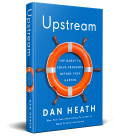Via the always-interesting Mojo Mom, a link to an interview with the professional “sensory analyst” Pat Patterson. As described by MM: “Imagine a day at work where you eat dry dog food and rate how meaty it is, and describe the smell of used cat litter. Pat has traveled to New Jersey to feel men’s faces after shaving, and flown to Indonesia to taste fresh fruit.” I wonder if you could just sign up for the Indonesia part.
Unexpectedness
Making sense of big numbers
It’s impossible to have an intuitive feel for a big number, like $1.2 trillion. It puts our intuition on TILT. We have a very real sense of how $1,200 is different than $200. With $1,200, you can make a mortgage payment (at least in my part of the country). With $200, you pay the cable & utility bills. But we have no intuitive feel for how $200 billion might be different than $1.2 trillion. What can you do with $1.2 trillion that you can’t do with $200 billion, or $50 billion? What is $1.2 trillion worth? And how do you manage to communicate its worth to others?
David Leonhardt of the Times has written a brilliant and hugely important column that grapples with this issue in the context of the Iraq war. It is essential reading.
Training your spouse like an exotic animal
When I read this fabulous Amy Sutherland piece in the Times last June, my Stickiness Radar started blazing. In fact, I wasn’t even aware that I HAD a Stickiness Radar until that moment. Much less that it could “blaze.” Does a radar “blaze”? Doubtful.
Sutherland discusses how, in the course of studying the methods used to train exotic animals (like elephants and baboons), she had a thought: Hey, I wonder if these methods would work on my husband. This piece is 6 for 6 on the principles of stickiness. After publication, she stayed on the Times Most E-Mailed List for what felt like 2 months. Now, bizarrely, she has re-emerged on the Most E-Mailed List, 7 months after the publication of her piece. That’s damn sticky. And it has given my blog post the veneer of topicality.
The Stickiness Aptitude Test
We worked with Guy Kawasaki (and the folks at Electric Pulp) to create a “Stickiness Aptitude Test.” It’s designed for entrepreneurs who want to assess the stickiness of their message. Check it out!
Also we had an interesting Q&A with him, including some discussion of the stickiness of products. In non-Made To Stick news, there’s a great blow-by-blow analysis of Guy’s LinkedIn page by two LinkedIn insiders. They’re essentially trying to make Guy’s page stickier (though they don’t use that language). Chip and I have been talking a lot lately about how to apply stickiness principles to personal promotion, as in a job interview situation. More to come.
Unexpectedness via Calvin and Hobbes
Matt from Olin College emailed us and said that the stuff in the book about unexpectedness — keeping people enthralled in your topic through mysteries and curiosity gaps — reminded him of an old Calvin and Hobbes cartoon. (Sorry, couldn’t find a link to the pic)
CALVIN: “I’m not going to do my math homework. Look at these unsolved problems. Here’s a number in mortal combat with another. One of them is going to get subtracted. But why? What will be left of him? If I answered these, it would kill the suspense. It would resolve the conflict and turn intriguing possibilities into boring old facts.”
HOBBES: “I never really thought about the literary possibilities of math.”
CALVIN: “I prefer to savor the mystery.”



